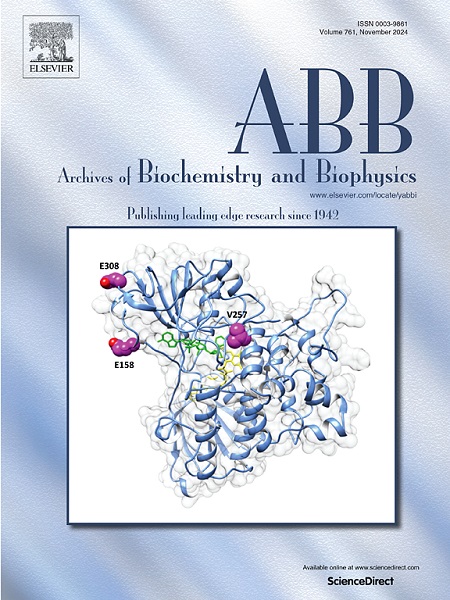癌细胞中丝氨酸和甘氨酸代谢输入和输出的量化。
IF 3.8
3区 生物学
Q2 BIOCHEMISTRY & MOLECULAR BIOLOGY
引用次数: 0
摘要
背景:肿瘤细胞中丝氨酸和甘氨酸代谢的重要性日益被认识,但对其代谢通量的量化仍然不完整,阻碍了对其的全面认识。本研究旨在量化癌细胞中丝氨酸和甘氨酸的代谢通量,重点关注它们的输入和输出,采用C-13同位素示踪和数学描述相结合的方法,以及同位素非平稳代谢通量分析。结果:在HeLa细胞中,丝氨酸摄取、丝氨酸合成途径(SSP)和其他来源(如蛋白质降解)分别贡献了71.2%、24.0%和5.7%的丝氨酸输入。相反,甘氨酸输入来自摄取(45.6%)、丝氨酸转化(45.1%)和其他来源(9.4%)。丝氨酸的输入通量是甘氨酸的7.3倍。丝氨酸主要指导大部分(94.7%)磷脂、鞘脂和蛋白质合成,只有一小部分(5.3%)指导单碳单位和甘氨酸的生产。甘氨酸主要支持蛋白质和核苷酸的合成(100%),不转化回丝氨酸。丝氨酸输出速率是甘氨酸输出速率的7.3倍。丝氨酸剥夺主要损害磷脂和鞘脂合成的输出,而其他输出则不受影响,而磷脂和鞘脂对细胞生长至关重要。AGS细胞表现出与HeLa细胞相当的丝氨酸和甘氨酸通量,尽管缺乏SSP活性。丝氨酸剥夺使AGS细胞的磷脂、鞘脂、蛋白质合成的输出通量停止,完全抑制细胞生长。结论:本研究通过对丝氨酸和甘氨酸代谢的定量研究,揭示了丝氨酸在不同代谢途径中的通量与癌细胞生长的关系,为治疗干预提供了潜在靶点,强调了丝氨酸在癌细胞生长过程中对磷脂和鞘脂合成的重要性。本文章由计算机程序翻译,如有差异,请以英文原文为准。

Quantification of the inputs and outputs of serine and glycine metabolism in cancer cells
Background
The significance of serine and glycine metabolism in cancer cells is increasingly acknowledged, yet the quantification of their metabolic flux remains incomplete, impeding a comprehensive understanding. This study aimed to quantify the metabolic flux of serine and glycine in cancer cells, focusing on their inputs and outputs, by means of Combinations of C-13 Isotopes Tracing and mathematical delineation, alongside Isotopically Nonstationary Metabolic Flux Analysis.
Results
In HeLa cells, serine uptake, the serine synthesis pathway (SSP), and other sources (e.g., protein degradation) contribute 71.2 %, 24.0 %, and 5.7 %, respectively, to serine inputs. Conversely, glycine inputs stem from uptake (45.6 %), conversion from serine (45.1 %), and other sources (9.4 %). Serine input flux surpasses glycine by 7.3-fold. Serine predominantly directs a major fraction (94.7 %) to phospholipid, sphingolipid, and protein synthesis, with only a minor fraction (5.3 %) directing towards one-carbon unit and glycine production. Glycine mainly supports protein and nucleotide synthesis (100 %), without conversion back to serine. Serine output rate exceeds glycine output rate by 7.3-fold. Serine deprivation mainly impairs output to synthesis of phospholipid and sphingolipid, crucial for cell growth, while other outputs unaffected. AGS cells exhibit comparable serine and glycine flux to HeLa cells, albeit lacking SSP activity. Serine deprivation in AGS cells halts output flux to phospholipid, sphingolipid, protein synthesis, completely inhibiting cell growth.
Conclusions
By providing quantitative insights into serine and glycine metabolism, this study delineates the association of serine flux to different metabolic pathway with cancer cell growth and offers potential targets for therapeutic intervention, highlighting the importance of serine flux to pathway for the synthesis of phospholipids and sphingolipids in cancer cells growth.
求助全文
通过发布文献求助,成功后即可免费获取论文全文。
去求助
来源期刊

Archives of biochemistry and biophysics
生物-生化与分子生物学
CiteScore
7.40
自引率
0.00%
发文量
245
审稿时长
26 days
期刊介绍:
Archives of Biochemistry and Biophysics publishes quality original articles and reviews in the developing areas of biochemistry and biophysics.
Research Areas Include:
• Enzyme and protein structure, function, regulation. Folding, turnover, and post-translational processing
• Biological oxidations, free radical reactions, redox signaling, oxygenases, P450 reactions
• Signal transduction, receptors, membrane transport, intracellular signals. Cellular and integrated metabolism.
 求助内容:
求助内容: 应助结果提醒方式:
应助结果提醒方式:


